Nokia's Strategic Change Management: Android Smartphone Launch Report
VerifiedAdded on 2021/02/22
|18
|5820
|339
Report
AI Summary
This report provides a comprehensive analysis of Nokia's strategic change management, focusing on its transition to Android smartphones and tablets. It begins with an executive summary and then delves into the introduction and background of strategic change management, highlighting the importance of adapting to market dynamics and competition. The report explores various change management models, including Lewin's, Kotter's, and Prosci's models, and how Nokia could apply them to manage the organizational transformation. It identifies the factors driving the need for change within Nokia, such as shifts in consumer preferences, technological advancements, and increased competition. The report also examines the implications of these changes on Nokia's resources and the importance of employee training and departmental collaboration. Furthermore, it addresses employee and market resistance to change, analyzing the challenges faced during Stephen Elop's tenure. Finally, the report outlines strategies to overcome these challenges, offering recommendations for successful change implementation and concluding with references to support the analysis.
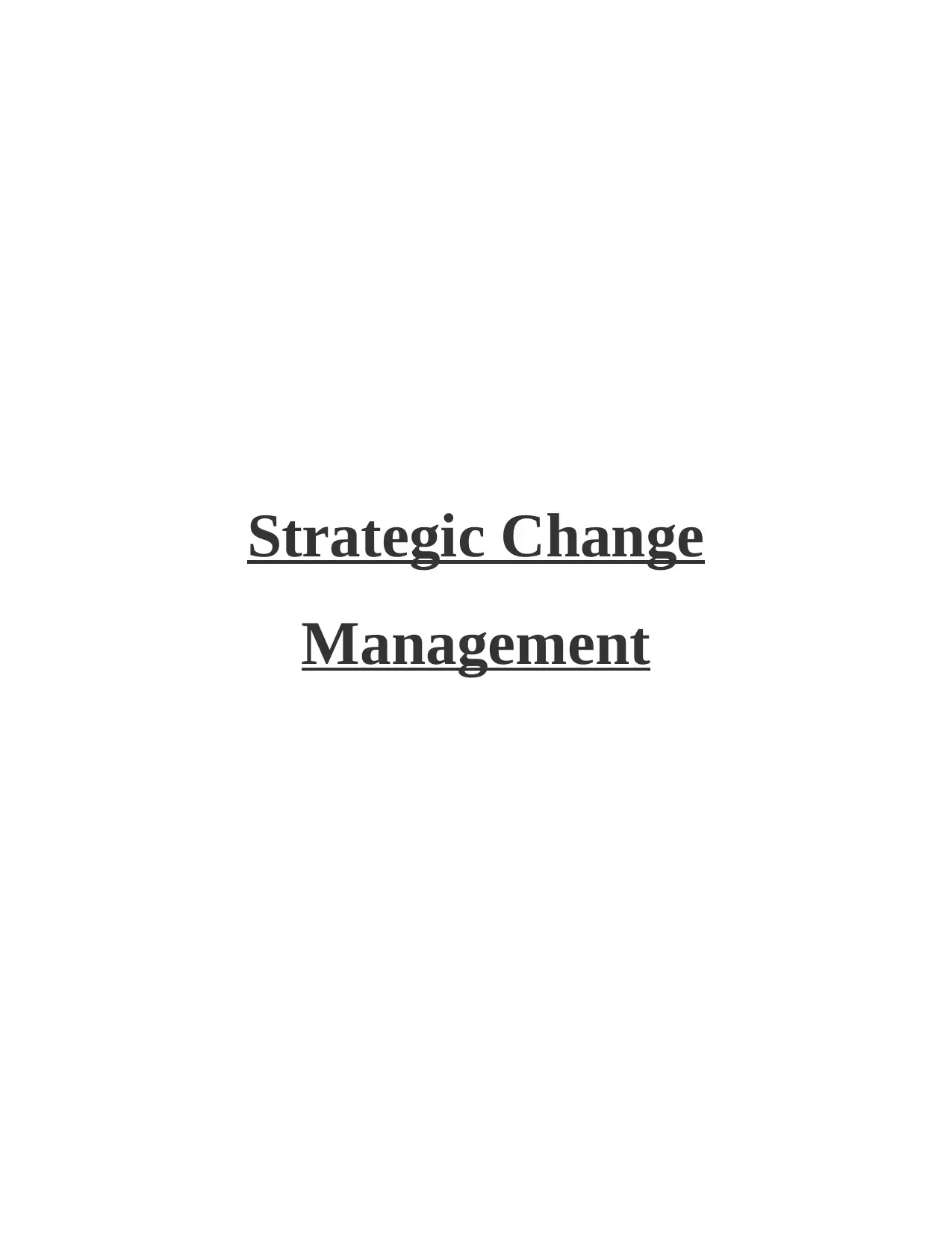
Strategic Change
Management
Management
Paraphrase This Document
Need a fresh take? Get an instant paraphrase of this document with our AI Paraphraser
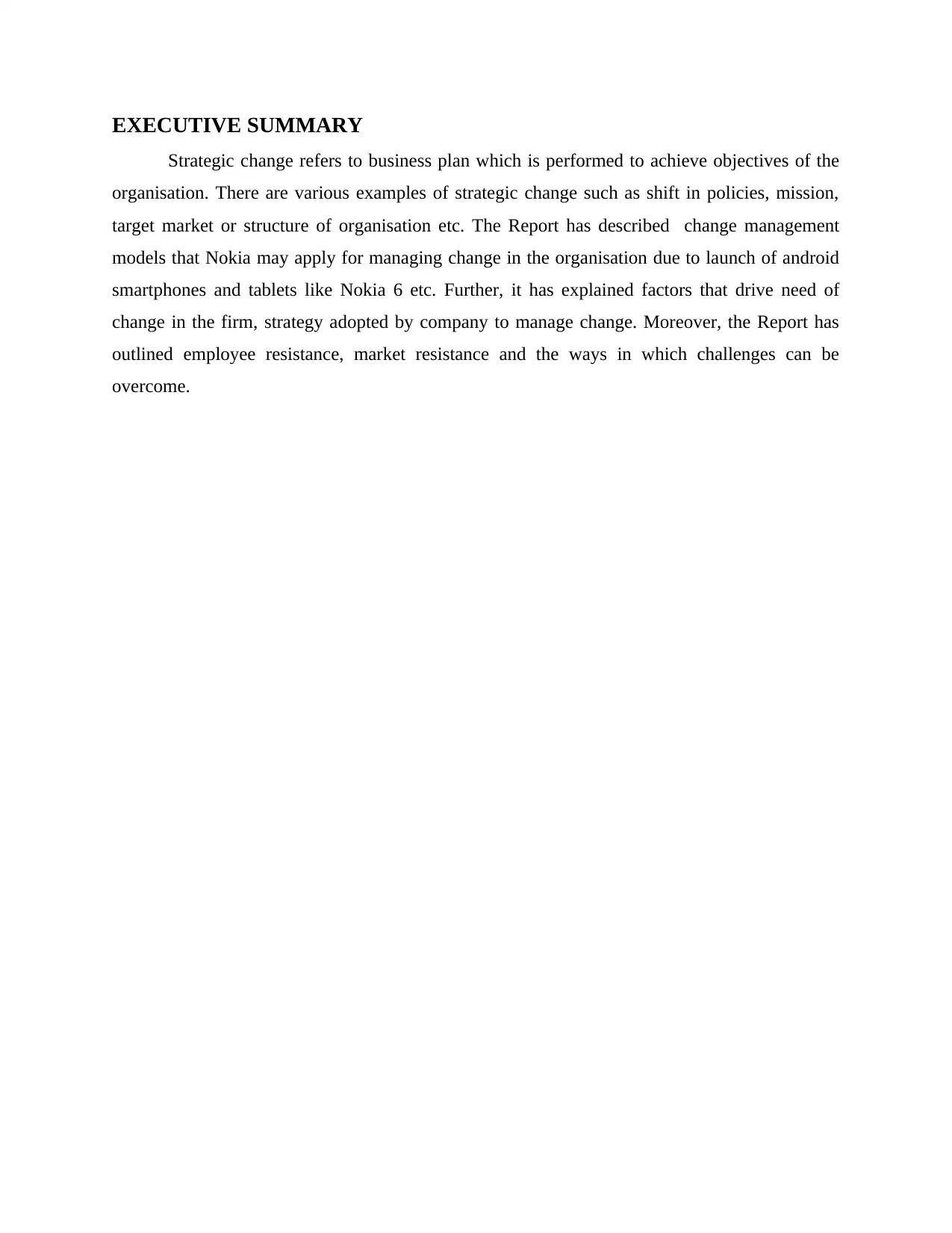
EXECUTIVE SUMMARY
Strategic change refers to business plan which is performed to achieve objectives of the
organisation. There are various examples of strategic change such as shift in policies, mission,
target market or structure of organisation etc. The Report has described change management
models that Nokia may apply for managing change in the organisation due to launch of android
smartphones and tablets like Nokia 6 etc. Further, it has explained factors that drive need of
change in the firm, strategy adopted by company to manage change. Moreover, the Report has
outlined employee resistance, market resistance and the ways in which challenges can be
overcome.
Strategic change refers to business plan which is performed to achieve objectives of the
organisation. There are various examples of strategic change such as shift in policies, mission,
target market or structure of organisation etc. The Report has described change management
models that Nokia may apply for managing change in the organisation due to launch of android
smartphones and tablets like Nokia 6 etc. Further, it has explained factors that drive need of
change in the firm, strategy adopted by company to manage change. Moreover, the Report has
outlined employee resistance, market resistance and the ways in which challenges can be
overcome.
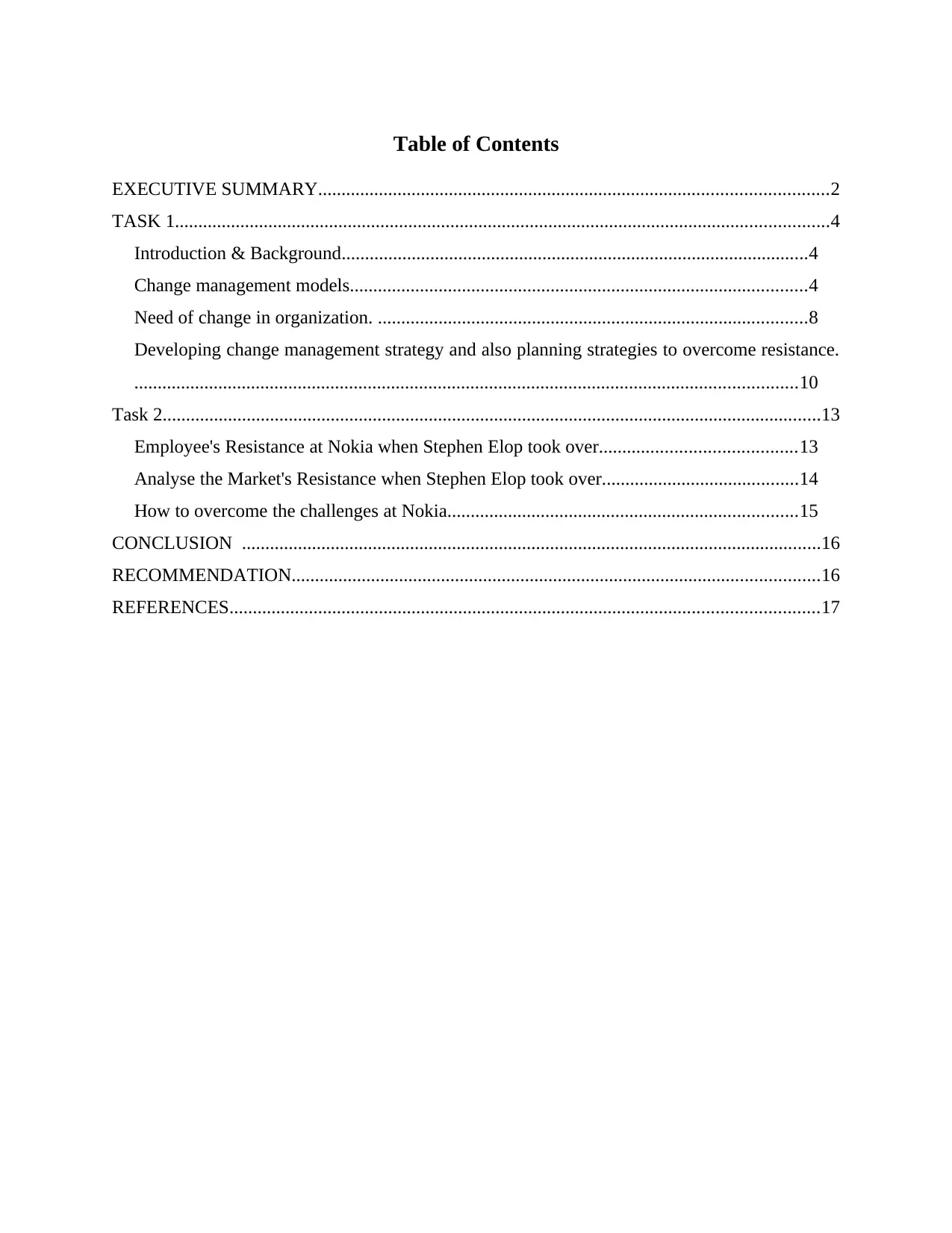
Table of Contents
EXECUTIVE SUMMARY.............................................................................................................2
TASK 1............................................................................................................................................4
Introduction & Background....................................................................................................4
Change management models..................................................................................................4
Need of change in organization. ............................................................................................8
Developing change management strategy and also planning strategies to overcome resistance.
..............................................................................................................................................10
Task 2.............................................................................................................................................13
Employee's Resistance at Nokia when Stephen Elop took over..........................................13
Analyse the Market's Resistance when Stephen Elop took over..........................................14
How to overcome the challenges at Nokia...........................................................................15
CONCLUSION ............................................................................................................................16
RECOMMENDATION.................................................................................................................16
REFERENCES..............................................................................................................................17
EXECUTIVE SUMMARY.............................................................................................................2
TASK 1............................................................................................................................................4
Introduction & Background....................................................................................................4
Change management models..................................................................................................4
Need of change in organization. ............................................................................................8
Developing change management strategy and also planning strategies to overcome resistance.
..............................................................................................................................................10
Task 2.............................................................................................................................................13
Employee's Resistance at Nokia when Stephen Elop took over..........................................13
Analyse the Market's Resistance when Stephen Elop took over..........................................14
How to overcome the challenges at Nokia...........................................................................15
CONCLUSION ............................................................................................................................16
RECOMMENDATION.................................................................................................................16
REFERENCES..............................................................................................................................17
⊘ This is a preview!⊘
Do you want full access?
Subscribe today to unlock all pages.

Trusted by 1+ million students worldwide
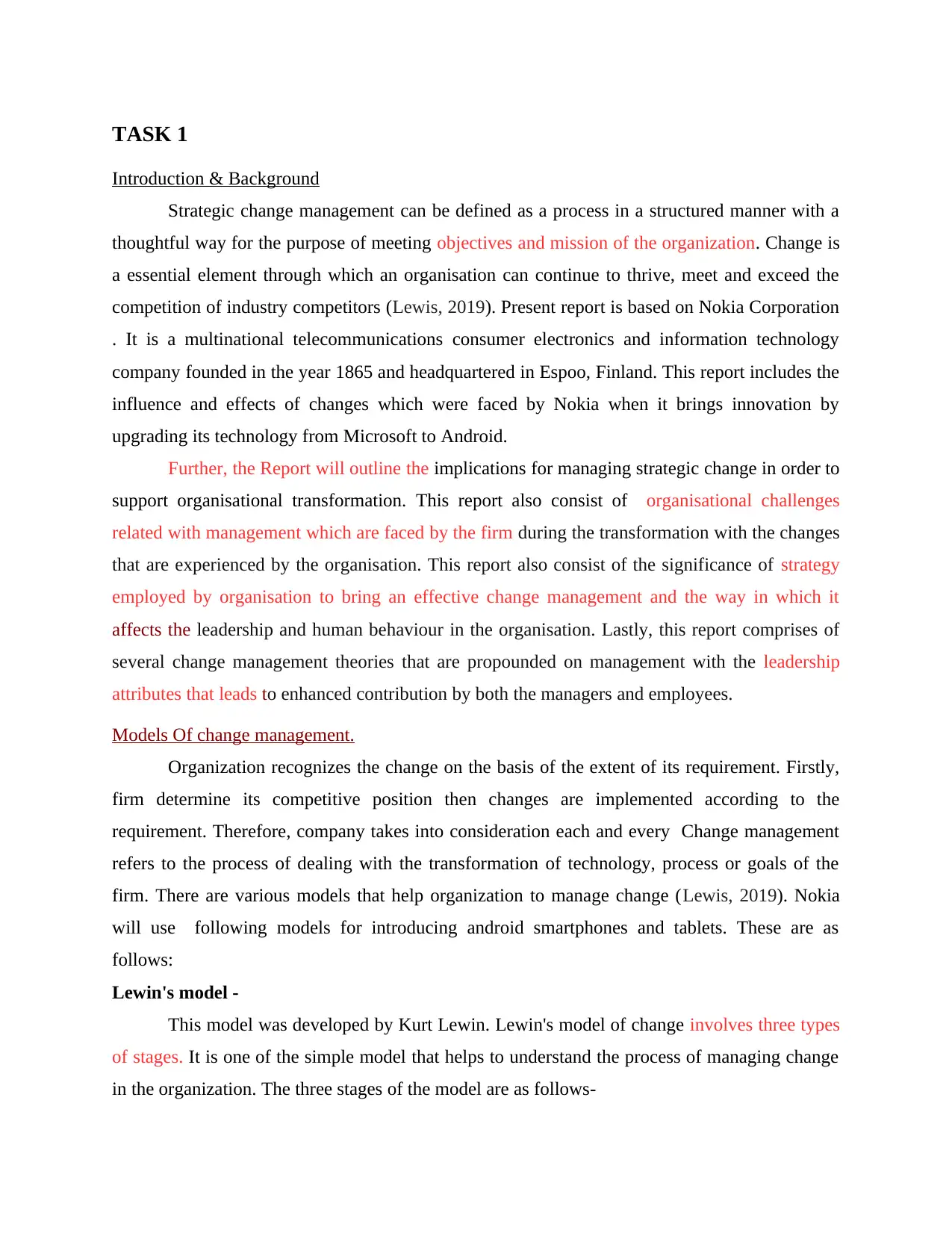
TASK 1
Introduction & Background
Strategic change management can be defined as a process in a structured manner with a
thoughtful way for the purpose of meeting objectives and mission of the organization. Change is
a essential element through which an organisation can continue to thrive, meet and exceed the
competition of industry competitors (Lewis, 2019). Present report is based on Nokia Corporation
. It is a multinational telecommunications consumer electronics and information technology
company founded in the year 1865 and headquartered in Espoo, Finland. This report includes the
influence and effects of changes which were faced by Nokia when it brings innovation by
upgrading its technology from Microsoft to Android.
Further, the Report will outline the implications for managing strategic change in order to
support organisational transformation. This report also consist of organisational challenges
related with management which are faced by the firm during the transformation with the changes
that are experienced by the organisation. This report also consist of the significance of strategy
employed by organisation to bring an effective change management and the way in which it
affects the leadership and human behaviour in the organisation. Lastly, this report comprises of
several change management theories that are propounded on management with the leadership
attributes that leads to enhanced contribution by both the managers and employees.
Models Of change management.
Organization recognizes the change on the basis of the extent of its requirement. Firstly,
firm determine its competitive position then changes are implemented according to the
requirement. Therefore, company takes into consideration each and every Change management
refers to the process of dealing with the transformation of technology, process or goals of the
firm. There are various models that help organization to manage change (Lewis, 2019). Nokia
will use following models for introducing android smartphones and tablets. These are as
follows:
Lewin's model -
This model was developed by Kurt Lewin. Lewin's model of change involves three types
of stages. It is one of the simple model that helps to understand the process of managing change
in the organization. The three stages of the model are as follows-
Introduction & Background
Strategic change management can be defined as a process in a structured manner with a
thoughtful way for the purpose of meeting objectives and mission of the organization. Change is
a essential element through which an organisation can continue to thrive, meet and exceed the
competition of industry competitors (Lewis, 2019). Present report is based on Nokia Corporation
. It is a multinational telecommunications consumer electronics and information technology
company founded in the year 1865 and headquartered in Espoo, Finland. This report includes the
influence and effects of changes which were faced by Nokia when it brings innovation by
upgrading its technology from Microsoft to Android.
Further, the Report will outline the implications for managing strategic change in order to
support organisational transformation. This report also consist of organisational challenges
related with management which are faced by the firm during the transformation with the changes
that are experienced by the organisation. This report also consist of the significance of strategy
employed by organisation to bring an effective change management and the way in which it
affects the leadership and human behaviour in the organisation. Lastly, this report comprises of
several change management theories that are propounded on management with the leadership
attributes that leads to enhanced contribution by both the managers and employees.
Models Of change management.
Organization recognizes the change on the basis of the extent of its requirement. Firstly,
firm determine its competitive position then changes are implemented according to the
requirement. Therefore, company takes into consideration each and every Change management
refers to the process of dealing with the transformation of technology, process or goals of the
firm. There are various models that help organization to manage change (Lewis, 2019). Nokia
will use following models for introducing android smartphones and tablets. These are as
follows:
Lewin's model -
This model was developed by Kurt Lewin. Lewin's model of change involves three types
of stages. It is one of the simple model that helps to understand the process of managing change
in the organization. The three stages of the model are as follows-
Paraphrase This Document
Need a fresh take? Get an instant paraphrase of this document with our AI Paraphraser
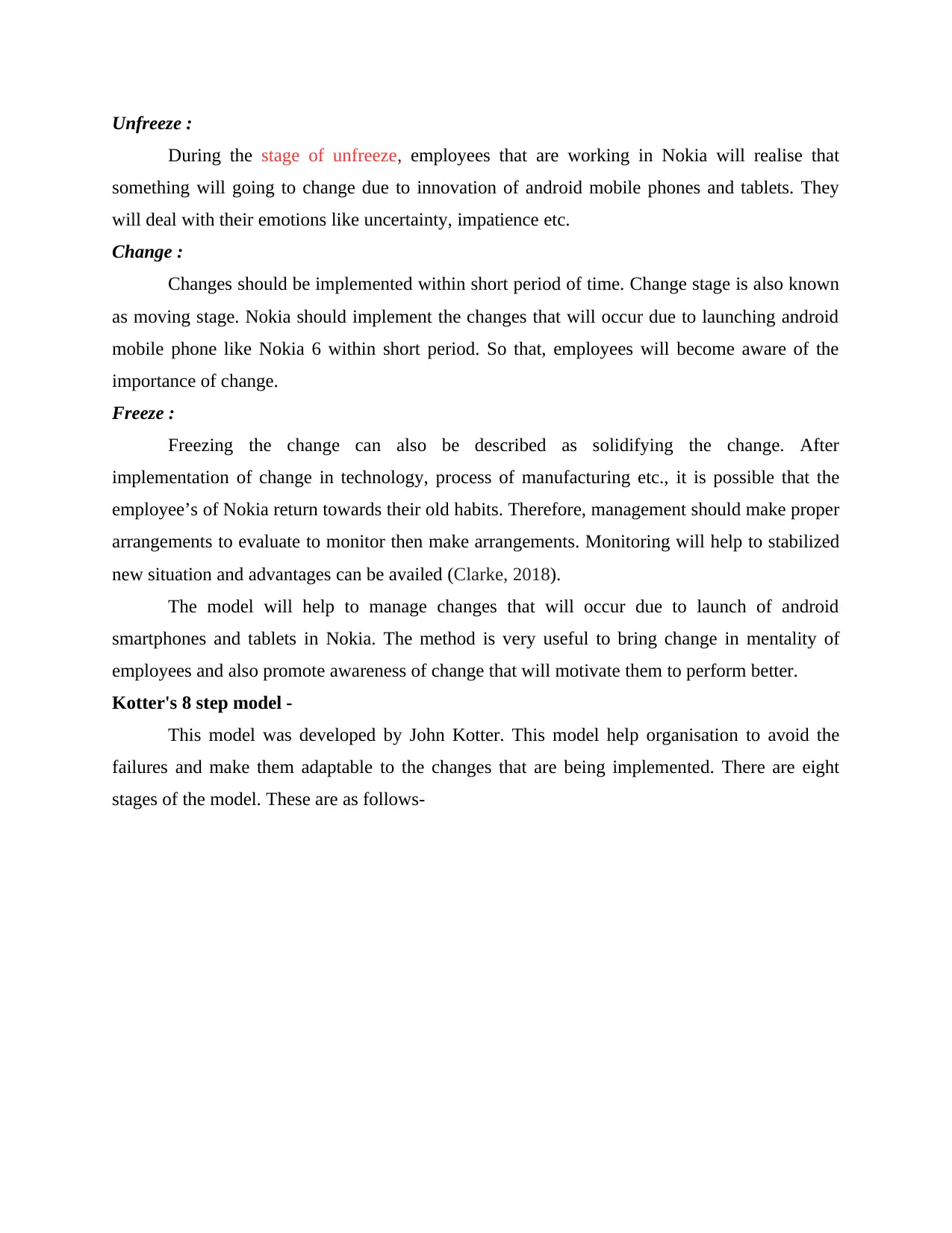
Unfreeze :
During the stage of unfreeze, employees that are working in Nokia will realise that
something will going to change due to innovation of android mobile phones and tablets. They
will deal with their emotions like uncertainty, impatience etc.
Change :
Changes should be implemented within short period of time. Change stage is also known
as moving stage. Nokia should implement the changes that will occur due to launching android
mobile phone like Nokia 6 within short period. So that, employees will become aware of the
importance of change.
Freeze :
Freezing the change can also be described as solidifying the change. After
implementation of change in technology, process of manufacturing etc., it is possible that the
employee’s of Nokia return towards their old habits. Therefore, management should make proper
arrangements to evaluate to monitor then make arrangements. Monitoring will help to stabilized
new situation and advantages can be availed (Clarke, 2018).
The model will help to manage changes that will occur due to launch of android
smartphones and tablets in Nokia. The method is very useful to bring change in mentality of
employees and also promote awareness of change that will motivate them to perform better.
Kotter's 8 step model -
This model was developed by John Kotter. This model help organisation to avoid the
failures and make them adaptable to the changes that are being implemented. There are eight
stages of the model. These are as follows-
During the stage of unfreeze, employees that are working in Nokia will realise that
something will going to change due to innovation of android mobile phones and tablets. They
will deal with their emotions like uncertainty, impatience etc.
Change :
Changes should be implemented within short period of time. Change stage is also known
as moving stage. Nokia should implement the changes that will occur due to launching android
mobile phone like Nokia 6 within short period. So that, employees will become aware of the
importance of change.
Freeze :
Freezing the change can also be described as solidifying the change. After
implementation of change in technology, process of manufacturing etc., it is possible that the
employee’s of Nokia return towards their old habits. Therefore, management should make proper
arrangements to evaluate to monitor then make arrangements. Monitoring will help to stabilized
new situation and advantages can be availed (Clarke, 2018).
The model will help to manage changes that will occur due to launch of android
smartphones and tablets in Nokia. The method is very useful to bring change in mentality of
employees and also promote awareness of change that will motivate them to perform better.
Kotter's 8 step model -
This model was developed by John Kotter. This model help organisation to avoid the
failures and make them adaptable to the changes that are being implemented. There are eight
stages of the model. These are as follows-
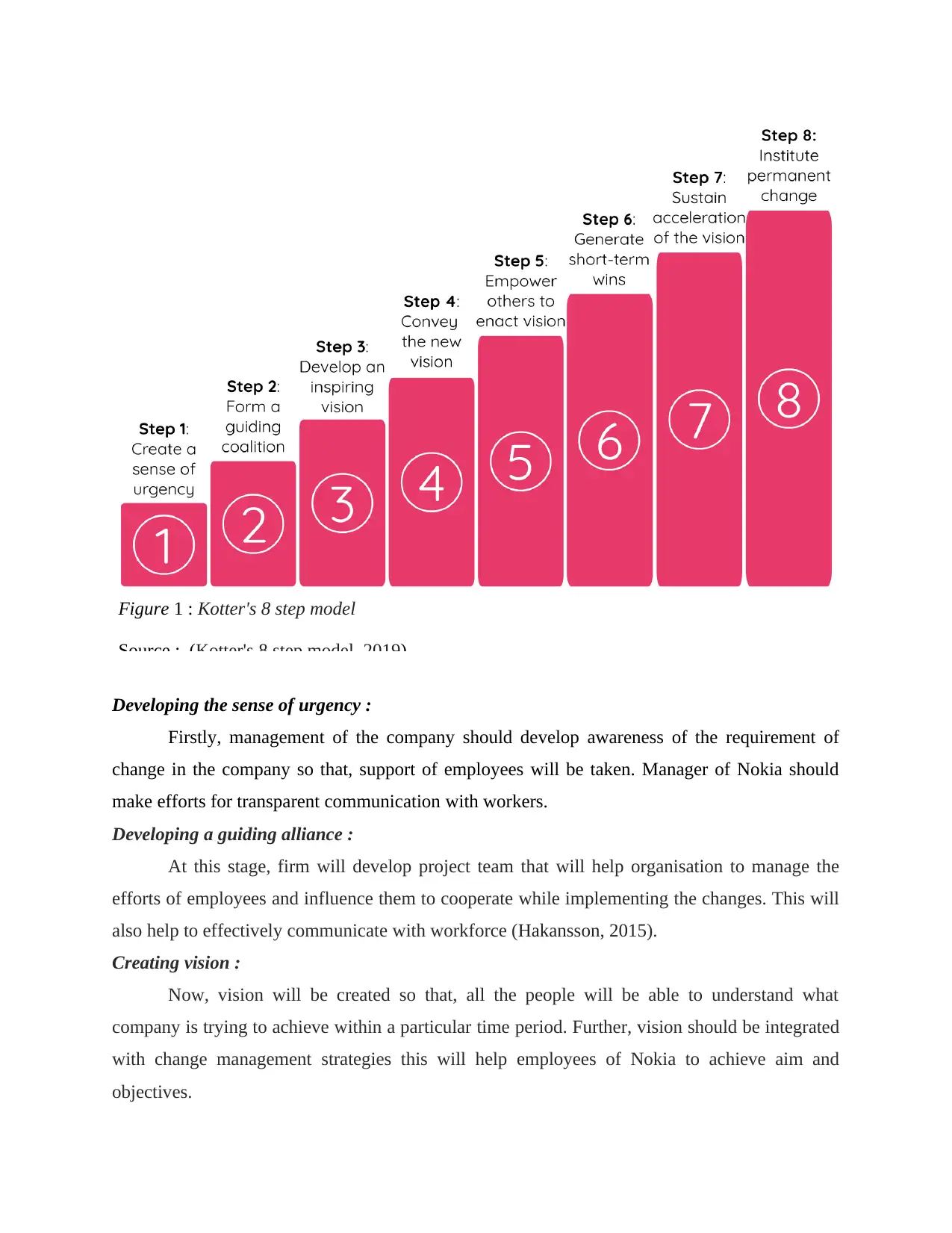
Developing the sense of urgency :
Firstly, management of the company should develop awareness of the requirement of
change in the company so that, support of employees will be taken. Manager of Nokia should
make efforts for transparent communication with workers.
Developing a guiding alliance :
At this stage, firm will develop project team that will help organisation to manage the
efforts of employees and influence them to cooperate while implementing the changes. This will
also help to effectively communicate with workforce (Hakansson, 2015).
Creating vision :
Now, vision will be created so that, all the people will be able to understand what
company is trying to achieve within a particular time period. Further, vision should be integrated
with change management strategies this will help employees of Nokia to achieve aim and
objectives.
Figure 1 : Kotter's 8 step model
Source : (Kotter's 8 step model, 2019)
Firstly, management of the company should develop awareness of the requirement of
change in the company so that, support of employees will be taken. Manager of Nokia should
make efforts for transparent communication with workers.
Developing a guiding alliance :
At this stage, firm will develop project team that will help organisation to manage the
efforts of employees and influence them to cooperate while implementing the changes. This will
also help to effectively communicate with workforce (Hakansson, 2015).
Creating vision :
Now, vision will be created so that, all the people will be able to understand what
company is trying to achieve within a particular time period. Further, vision should be integrated
with change management strategies this will help employees of Nokia to achieve aim and
objectives.
Figure 1 : Kotter's 8 step model
Source : (Kotter's 8 step model, 2019)
⊘ This is a preview!⊘
Do you want full access?
Subscribe today to unlock all pages.

Trusted by 1+ million students worldwide
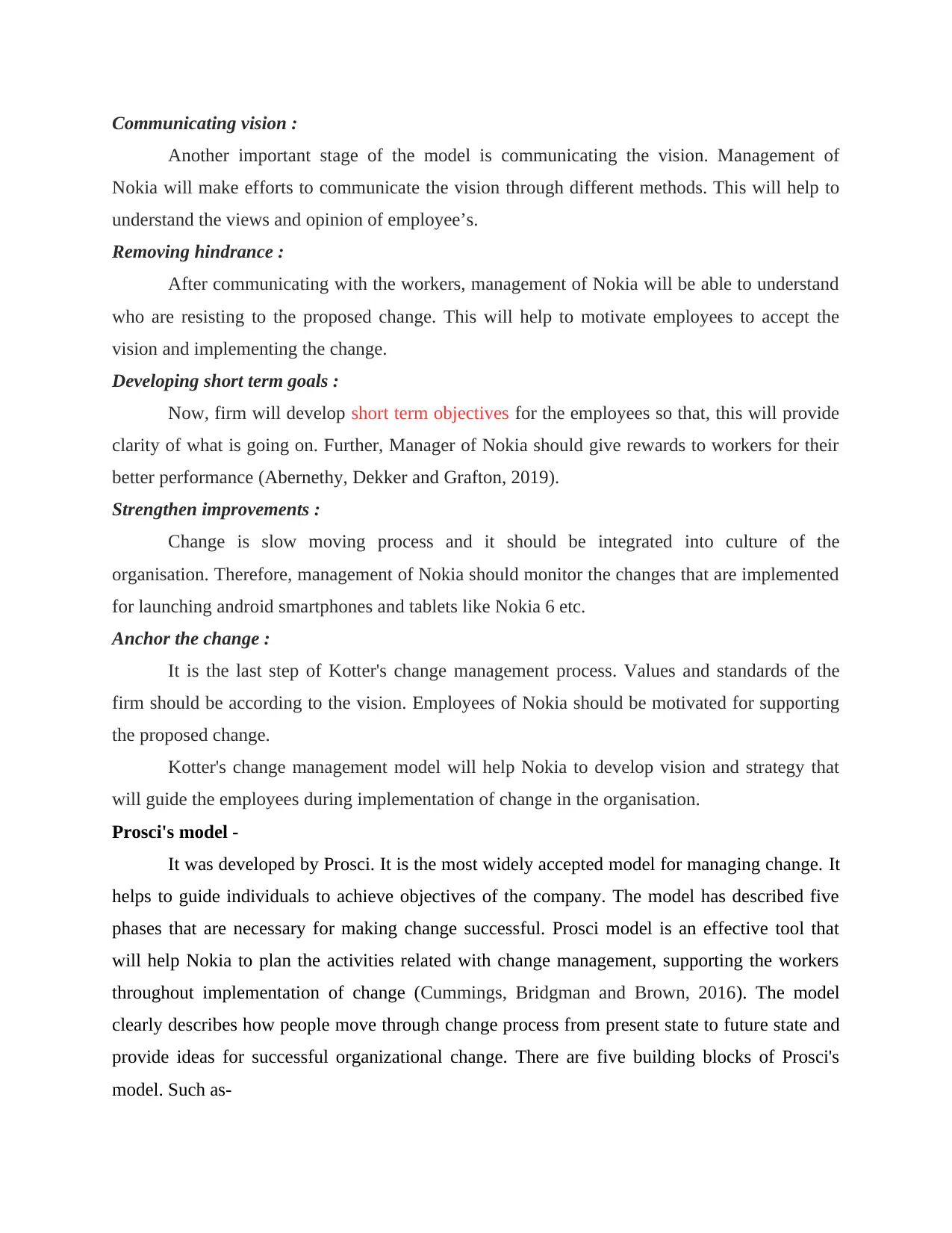
Communicating vision :
Another important stage of the model is communicating the vision. Management of
Nokia will make efforts to communicate the vision through different methods. This will help to
understand the views and opinion of employee’s.
Removing hindrance :
After communicating with the workers, management of Nokia will be able to understand
who are resisting to the proposed change. This will help to motivate employees to accept the
vision and implementing the change.
Developing short term goals :
Now, firm will develop short term objectives for the employees so that, this will provide
clarity of what is going on. Further, Manager of Nokia should give rewards to workers for their
better performance (Abernethy, Dekker and Grafton, 2019).
Strengthen improvements :
Change is slow moving process and it should be integrated into culture of the
organisation. Therefore, management of Nokia should monitor the changes that are implemented
for launching android smartphones and tablets like Nokia 6 etc.
Anchor the change :
It is the last step of Kotter's change management process. Values and standards of the
firm should be according to the vision. Employees of Nokia should be motivated for supporting
the proposed change.
Kotter's change management model will help Nokia to develop vision and strategy that
will guide the employees during implementation of change in the organisation.
Prosci's model -
It was developed by Prosci. It is the most widely accepted model for managing change. It
helps to guide individuals to achieve objectives of the company. The model has described five
phases that are necessary for making change successful. Prosci model is an effective tool that
will help Nokia to plan the activities related with change management, supporting the workers
throughout implementation of change (Cummings, Bridgman and Brown, 2016). The model
clearly describes how people move through change process from present state to future state and
provide ideas for successful organizational change. There are five building blocks of Prosci's
model. Such as-
Another important stage of the model is communicating the vision. Management of
Nokia will make efforts to communicate the vision through different methods. This will help to
understand the views and opinion of employee’s.
Removing hindrance :
After communicating with the workers, management of Nokia will be able to understand
who are resisting to the proposed change. This will help to motivate employees to accept the
vision and implementing the change.
Developing short term goals :
Now, firm will develop short term objectives for the employees so that, this will provide
clarity of what is going on. Further, Manager of Nokia should give rewards to workers for their
better performance (Abernethy, Dekker and Grafton, 2019).
Strengthen improvements :
Change is slow moving process and it should be integrated into culture of the
organisation. Therefore, management of Nokia should monitor the changes that are implemented
for launching android smartphones and tablets like Nokia 6 etc.
Anchor the change :
It is the last step of Kotter's change management process. Values and standards of the
firm should be according to the vision. Employees of Nokia should be motivated for supporting
the proposed change.
Kotter's change management model will help Nokia to develop vision and strategy that
will guide the employees during implementation of change in the organisation.
Prosci's model -
It was developed by Prosci. It is the most widely accepted model for managing change. It
helps to guide individuals to achieve objectives of the company. The model has described five
phases that are necessary for making change successful. Prosci model is an effective tool that
will help Nokia to plan the activities related with change management, supporting the workers
throughout implementation of change (Cummings, Bridgman and Brown, 2016). The model
clearly describes how people move through change process from present state to future state and
provide ideas for successful organizational change. There are five building blocks of Prosci's
model. Such as-
Paraphrase This Document
Need a fresh take? Get an instant paraphrase of this document with our AI Paraphraser
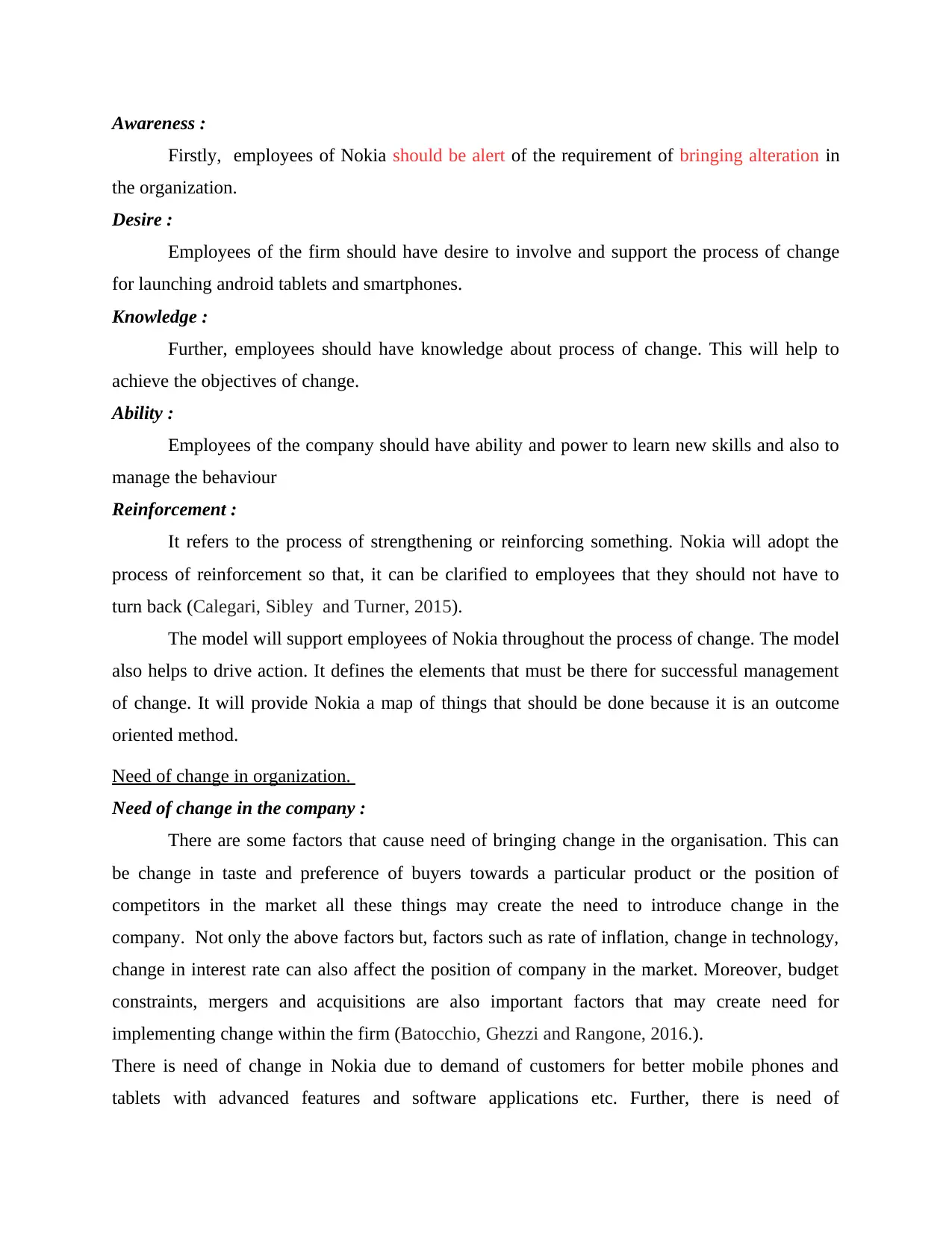
Awareness :
Firstly, employees of Nokia should be alert of the requirement of bringing alteration in
the organization.
Desire :
Employees of the firm should have desire to involve and support the process of change
for launching android tablets and smartphones.
Knowledge :
Further, employees should have knowledge about process of change. This will help to
achieve the objectives of change.
Ability :
Employees of the company should have ability and power to learn new skills and also to
manage the behaviour
Reinforcement :
It refers to the process of strengthening or reinforcing something. Nokia will adopt the
process of reinforcement so that, it can be clarified to employees that they should not have to
turn back (Calegari, Sibley and Turner, 2015).
The model will support employees of Nokia throughout the process of change. The model
also helps to drive action. It defines the elements that must be there for successful management
of change. It will provide Nokia a map of things that should be done because it is an outcome
oriented method.
Need of change in organization.
Need of change in the company :
There are some factors that cause need of bringing change in the organisation. This can
be change in taste and preference of buyers towards a particular product or the position of
competitors in the market all these things may create the need to introduce change in the
company. Not only the above factors but, factors such as rate of inflation, change in technology,
change in interest rate can also affect the position of company in the market. Moreover, budget
constraints, mergers and acquisitions are also important factors that may create need for
implementing change within the firm (Batocchio, Ghezzi and Rangone, 2016.).
There is need of change in Nokia due to demand of customers for better mobile phones and
tablets with advanced features and software applications etc. Further, there is need of
Firstly, employees of Nokia should be alert of the requirement of bringing alteration in
the organization.
Desire :
Employees of the firm should have desire to involve and support the process of change
for launching android tablets and smartphones.
Knowledge :
Further, employees should have knowledge about process of change. This will help to
achieve the objectives of change.
Ability :
Employees of the company should have ability and power to learn new skills and also to
manage the behaviour
Reinforcement :
It refers to the process of strengthening or reinforcing something. Nokia will adopt the
process of reinforcement so that, it can be clarified to employees that they should not have to
turn back (Calegari, Sibley and Turner, 2015).
The model will support employees of Nokia throughout the process of change. The model
also helps to drive action. It defines the elements that must be there for successful management
of change. It will provide Nokia a map of things that should be done because it is an outcome
oriented method.
Need of change in organization.
Need of change in the company :
There are some factors that cause need of bringing change in the organisation. This can
be change in taste and preference of buyers towards a particular product or the position of
competitors in the market all these things may create the need to introduce change in the
company. Not only the above factors but, factors such as rate of inflation, change in technology,
change in interest rate can also affect the position of company in the market. Moreover, budget
constraints, mergers and acquisitions are also important factors that may create need for
implementing change within the firm (Batocchio, Ghezzi and Rangone, 2016.).
There is need of change in Nokia due to demand of customers for better mobile phones and
tablets with advanced features and software applications etc. Further, there is need of
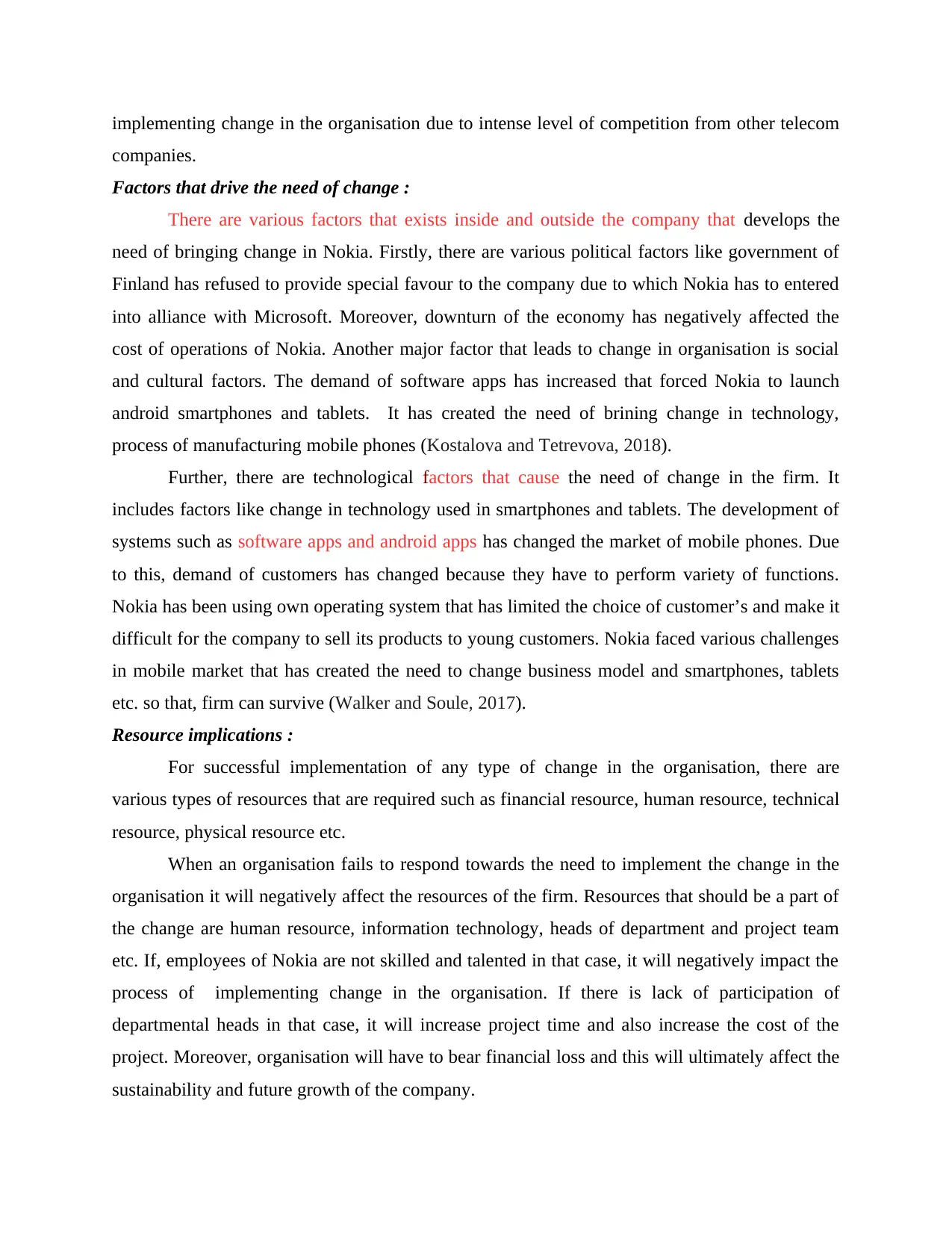
implementing change in the organisation due to intense level of competition from other telecom
companies.
Factors that drive the need of change :
There are various factors that exists inside and outside the company that develops the
need of bringing change in Nokia. Firstly, there are various political factors like government of
Finland has refused to provide special favour to the company due to which Nokia has to entered
into alliance with Microsoft. Moreover, downturn of the economy has negatively affected the
cost of operations of Nokia. Another major factor that leads to change in organisation is social
and cultural factors. The demand of software apps has increased that forced Nokia to launch
android smartphones and tablets. It has created the need of brining change in technology,
process of manufacturing mobile phones (Kostalova and Tetrevova, 2018).
Further, there are technological factors that cause the need of change in the firm. It
includes factors like change in technology used in smartphones and tablets. The development of
systems such as software apps and android apps has changed the market of mobile phones. Due
to this, demand of customers has changed because they have to perform variety of functions.
Nokia has been using own operating system that has limited the choice of customer’s and make it
difficult for the company to sell its products to young customers. Nokia faced various challenges
in mobile market that has created the need to change business model and smartphones, tablets
etc. so that, firm can survive (Walker and Soule, 2017).
Resource implications :
For successful implementation of any type of change in the organisation, there are
various types of resources that are required such as financial resource, human resource, technical
resource, physical resource etc.
When an organisation fails to respond towards the need to implement the change in the
organisation it will negatively affect the resources of the firm. Resources that should be a part of
the change are human resource, information technology, heads of department and project team
etc. If, employees of Nokia are not skilled and talented in that case, it will negatively impact the
process of implementing change in the organisation. If there is lack of participation of
departmental heads in that case, it will increase project time and also increase the cost of the
project. Moreover, organisation will have to bear financial loss and this will ultimately affect the
sustainability and future growth of the company.
companies.
Factors that drive the need of change :
There are various factors that exists inside and outside the company that develops the
need of bringing change in Nokia. Firstly, there are various political factors like government of
Finland has refused to provide special favour to the company due to which Nokia has to entered
into alliance with Microsoft. Moreover, downturn of the economy has negatively affected the
cost of operations of Nokia. Another major factor that leads to change in organisation is social
and cultural factors. The demand of software apps has increased that forced Nokia to launch
android smartphones and tablets. It has created the need of brining change in technology,
process of manufacturing mobile phones (Kostalova and Tetrevova, 2018).
Further, there are technological factors that cause the need of change in the firm. It
includes factors like change in technology used in smartphones and tablets. The development of
systems such as software apps and android apps has changed the market of mobile phones. Due
to this, demand of customers has changed because they have to perform variety of functions.
Nokia has been using own operating system that has limited the choice of customer’s and make it
difficult for the company to sell its products to young customers. Nokia faced various challenges
in mobile market that has created the need to change business model and smartphones, tablets
etc. so that, firm can survive (Walker and Soule, 2017).
Resource implications :
For successful implementation of any type of change in the organisation, there are
various types of resources that are required such as financial resource, human resource, technical
resource, physical resource etc.
When an organisation fails to respond towards the need to implement the change in the
organisation it will negatively affect the resources of the firm. Resources that should be a part of
the change are human resource, information technology, heads of department and project team
etc. If, employees of Nokia are not skilled and talented in that case, it will negatively impact the
process of implementing change in the organisation. If there is lack of participation of
departmental heads in that case, it will increase project time and also increase the cost of the
project. Moreover, organisation will have to bear financial loss and this will ultimately affect the
sustainability and future growth of the company.
⊘ This is a preview!⊘
Do you want full access?
Subscribe today to unlock all pages.

Trusted by 1+ million students worldwide
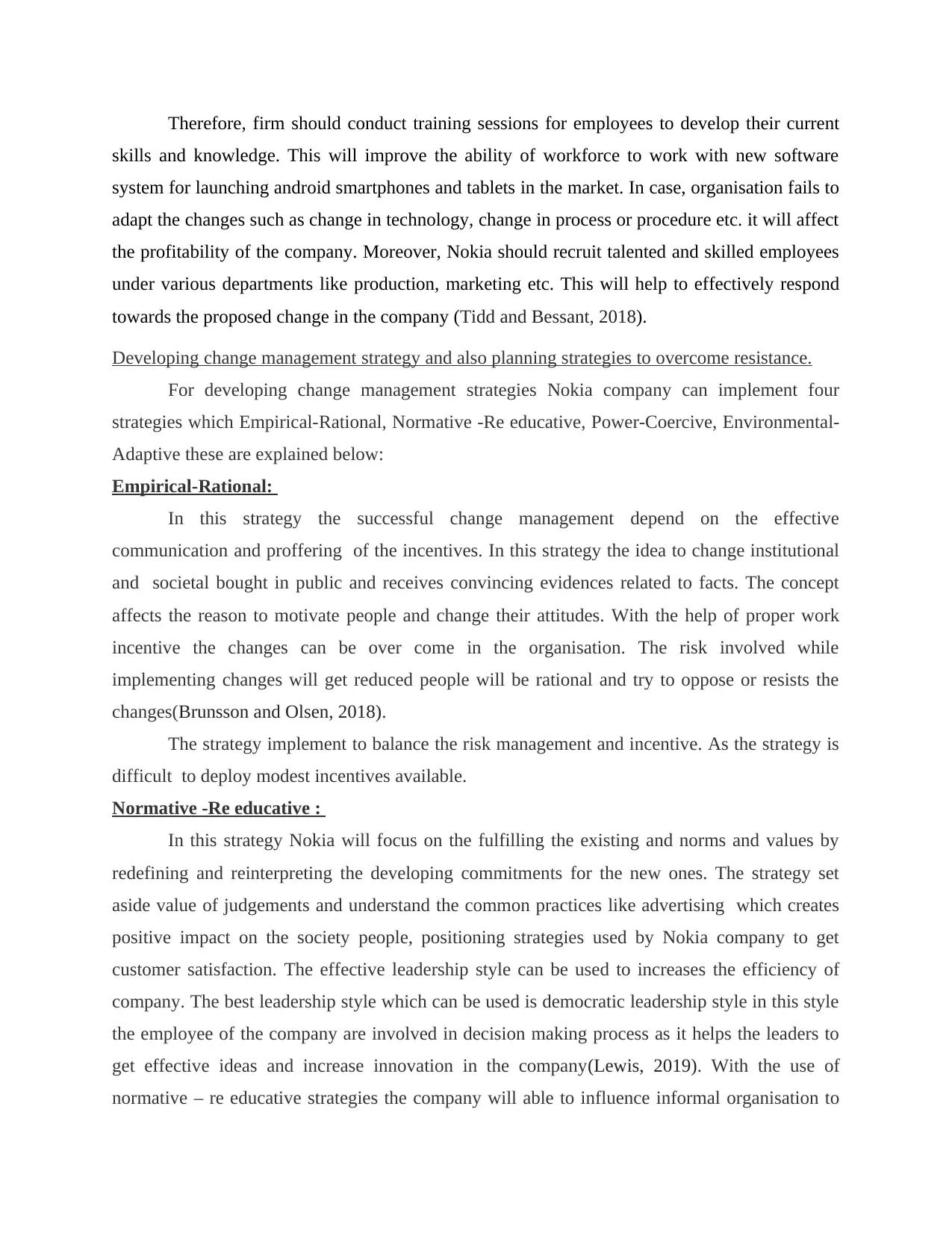
Therefore, firm should conduct training sessions for employees to develop their current
skills and knowledge. This will improve the ability of workforce to work with new software
system for launching android smartphones and tablets in the market. In case, organisation fails to
adapt the changes such as change in technology, change in process or procedure etc. it will affect
the profitability of the company. Moreover, Nokia should recruit talented and skilled employees
under various departments like production, marketing etc. This will help to effectively respond
towards the proposed change in the company (Tidd and Bessant, 2018).
Developing change management strategy and also planning strategies to overcome resistance.
For developing change management strategies Nokia company can implement four
strategies which Empirical-Rational, Normative -Re educative, Power-Coercive, Environmental-
Adaptive these are explained below:
Empirical-Rational:
In this strategy the successful change management depend on the effective
communication and proffering of the incentives. In this strategy the idea to change institutional
and societal bought in public and receives convincing evidences related to facts. The concept
affects the reason to motivate people and change their attitudes. With the help of proper work
incentive the changes can be over come in the organisation. The risk involved while
implementing changes will get reduced people will be rational and try to oppose or resists the
changes(Brunsson and Olsen, 2018).
The strategy implement to balance the risk management and incentive. As the strategy is
difficult to deploy modest incentives available.
Normative -Re educative :
In this strategy Nokia will focus on the fulfilling the existing and norms and values by
redefining and reinterpreting the developing commitments for the new ones. The strategy set
aside value of judgements and understand the common practices like advertising which creates
positive impact on the society people, positioning strategies used by Nokia company to get
customer satisfaction. The effective leadership style can be used to increases the efficiency of
company. The best leadership style which can be used is democratic leadership style in this style
the employee of the company are involved in decision making process as it helps the leaders to
get effective ideas and increase innovation in the company(Lewis, 2019). With the use of
normative – re educative strategies the company will able to influence informal organisation to
skills and knowledge. This will improve the ability of workforce to work with new software
system for launching android smartphones and tablets in the market. In case, organisation fails to
adapt the changes such as change in technology, change in process or procedure etc. it will affect
the profitability of the company. Moreover, Nokia should recruit talented and skilled employees
under various departments like production, marketing etc. This will help to effectively respond
towards the proposed change in the company (Tidd and Bessant, 2018).
Developing change management strategy and also planning strategies to overcome resistance.
For developing change management strategies Nokia company can implement four
strategies which Empirical-Rational, Normative -Re educative, Power-Coercive, Environmental-
Adaptive these are explained below:
Empirical-Rational:
In this strategy the successful change management depend on the effective
communication and proffering of the incentives. In this strategy the idea to change institutional
and societal bought in public and receives convincing evidences related to facts. The concept
affects the reason to motivate people and change their attitudes. With the help of proper work
incentive the changes can be over come in the organisation. The risk involved while
implementing changes will get reduced people will be rational and try to oppose or resists the
changes(Brunsson and Olsen, 2018).
The strategy implement to balance the risk management and incentive. As the strategy is
difficult to deploy modest incentives available.
Normative -Re educative :
In this strategy Nokia will focus on the fulfilling the existing and norms and values by
redefining and reinterpreting the developing commitments for the new ones. The strategy set
aside value of judgements and understand the common practices like advertising which creates
positive impact on the society people, positioning strategies used by Nokia company to get
customer satisfaction. The effective leadership style can be used to increases the efficiency of
company. The best leadership style which can be used is democratic leadership style in this style
the employee of the company are involved in decision making process as it helps the leaders to
get effective ideas and increase innovation in the company(Lewis, 2019). With the use of
normative – re educative strategies the company will able to influence informal organisation to
Paraphrase This Document
Need a fresh take? Get an instant paraphrase of this document with our AI Paraphraser
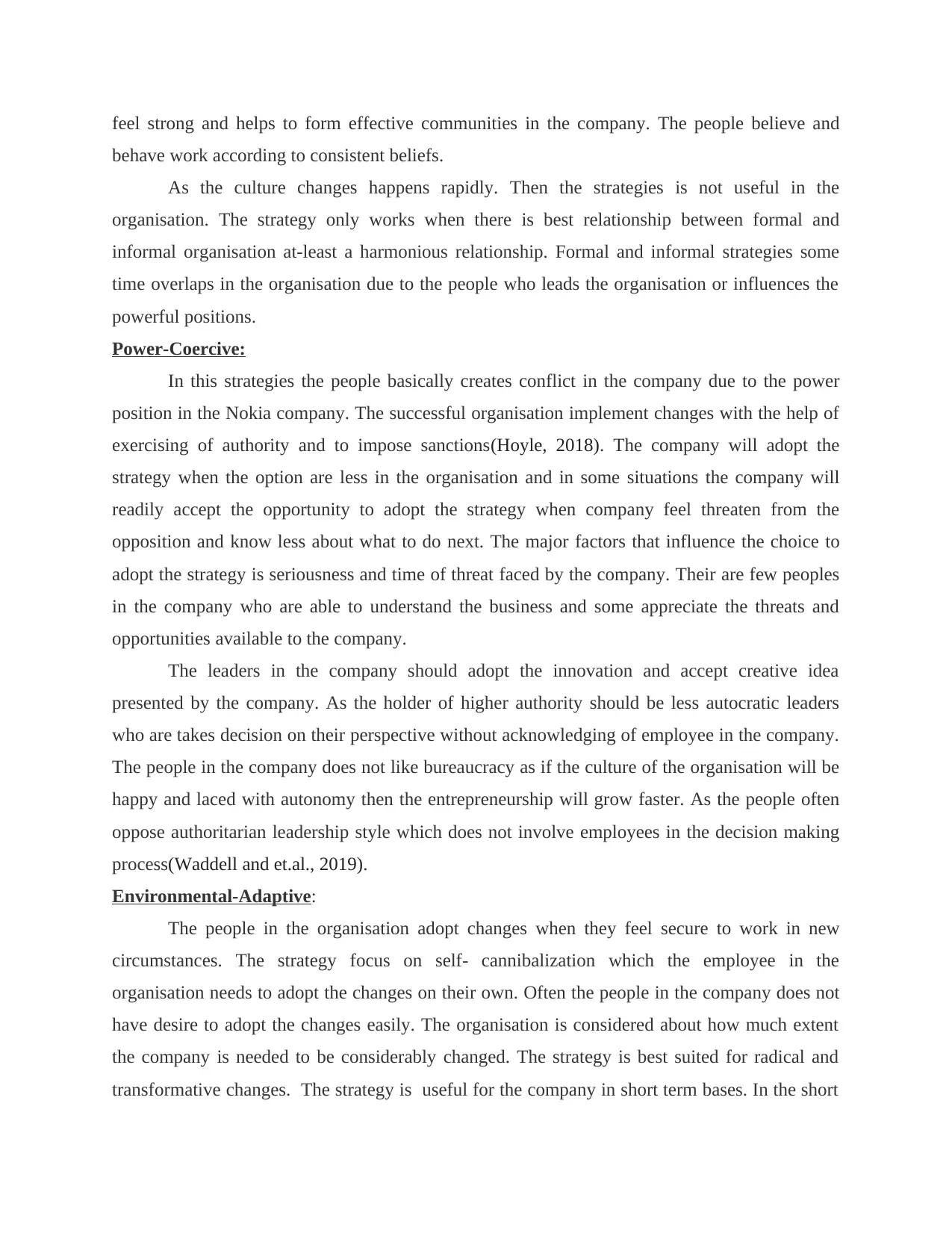
feel strong and helps to form effective communities in the company. The people believe and
behave work according to consistent beliefs.
As the culture changes happens rapidly. Then the strategies is not useful in the
organisation. The strategy only works when there is best relationship between formal and
informal organisation at-least a harmonious relationship. Formal and informal strategies some
time overlaps in the organisation due to the people who leads the organisation or influences the
powerful positions.
Power-Coercive:
In this strategies the people basically creates conflict in the company due to the power
position in the Nokia company. The successful organisation implement changes with the help of
exercising of authority and to impose sanctions(Hoyle, 2018). The company will adopt the
strategy when the option are less in the organisation and in some situations the company will
readily accept the opportunity to adopt the strategy when company feel threaten from the
opposition and know less about what to do next. The major factors that influence the choice to
adopt the strategy is seriousness and time of threat faced by the company. Their are few peoples
in the company who are able to understand the business and some appreciate the threats and
opportunities available to the company.
The leaders in the company should adopt the innovation and accept creative idea
presented by the company. As the holder of higher authority should be less autocratic leaders
who are takes decision on their perspective without acknowledging of employee in the company.
The people in the company does not like bureaucracy as if the culture of the organisation will be
happy and laced with autonomy then the entrepreneurship will grow faster. As the people often
oppose authoritarian leadership style which does not involve employees in the decision making
process(Waddell and et.al., 2019).
Environmental-Adaptive:
The people in the organisation adopt changes when they feel secure to work in new
circumstances. The strategy focus on self- cannibalization which the employee in the
organisation needs to adopt the changes on their own. Often the people in the company does not
have desire to adopt the changes easily. The organisation is considered about how much extent
the company is needed to be considerably changed. The strategy is best suited for radical and
transformative changes. The strategy is useful for the company in short term bases. In the short
behave work according to consistent beliefs.
As the culture changes happens rapidly. Then the strategies is not useful in the
organisation. The strategy only works when there is best relationship between formal and
informal organisation at-least a harmonious relationship. Formal and informal strategies some
time overlaps in the organisation due to the people who leads the organisation or influences the
powerful positions.
Power-Coercive:
In this strategies the people basically creates conflict in the company due to the power
position in the Nokia company. The successful organisation implement changes with the help of
exercising of authority and to impose sanctions(Hoyle, 2018). The company will adopt the
strategy when the option are less in the organisation and in some situations the company will
readily accept the opportunity to adopt the strategy when company feel threaten from the
opposition and know less about what to do next. The major factors that influence the choice to
adopt the strategy is seriousness and time of threat faced by the company. Their are few peoples
in the company who are able to understand the business and some appreciate the threats and
opportunities available to the company.
The leaders in the company should adopt the innovation and accept creative idea
presented by the company. As the holder of higher authority should be less autocratic leaders
who are takes decision on their perspective without acknowledging of employee in the company.
The people in the company does not like bureaucracy as if the culture of the organisation will be
happy and laced with autonomy then the entrepreneurship will grow faster. As the people often
oppose authoritarian leadership style which does not involve employees in the decision making
process(Waddell and et.al., 2019).
Environmental-Adaptive:
The people in the organisation adopt changes when they feel secure to work in new
circumstances. The strategy focus on self- cannibalization which the employee in the
organisation needs to adopt the changes on their own. Often the people in the company does not
have desire to adopt the changes easily. The organisation is considered about how much extent
the company is needed to be considerably changed. The strategy is best suited for radical and
transformative changes. The strategy is useful for the company in short term bases. In the short
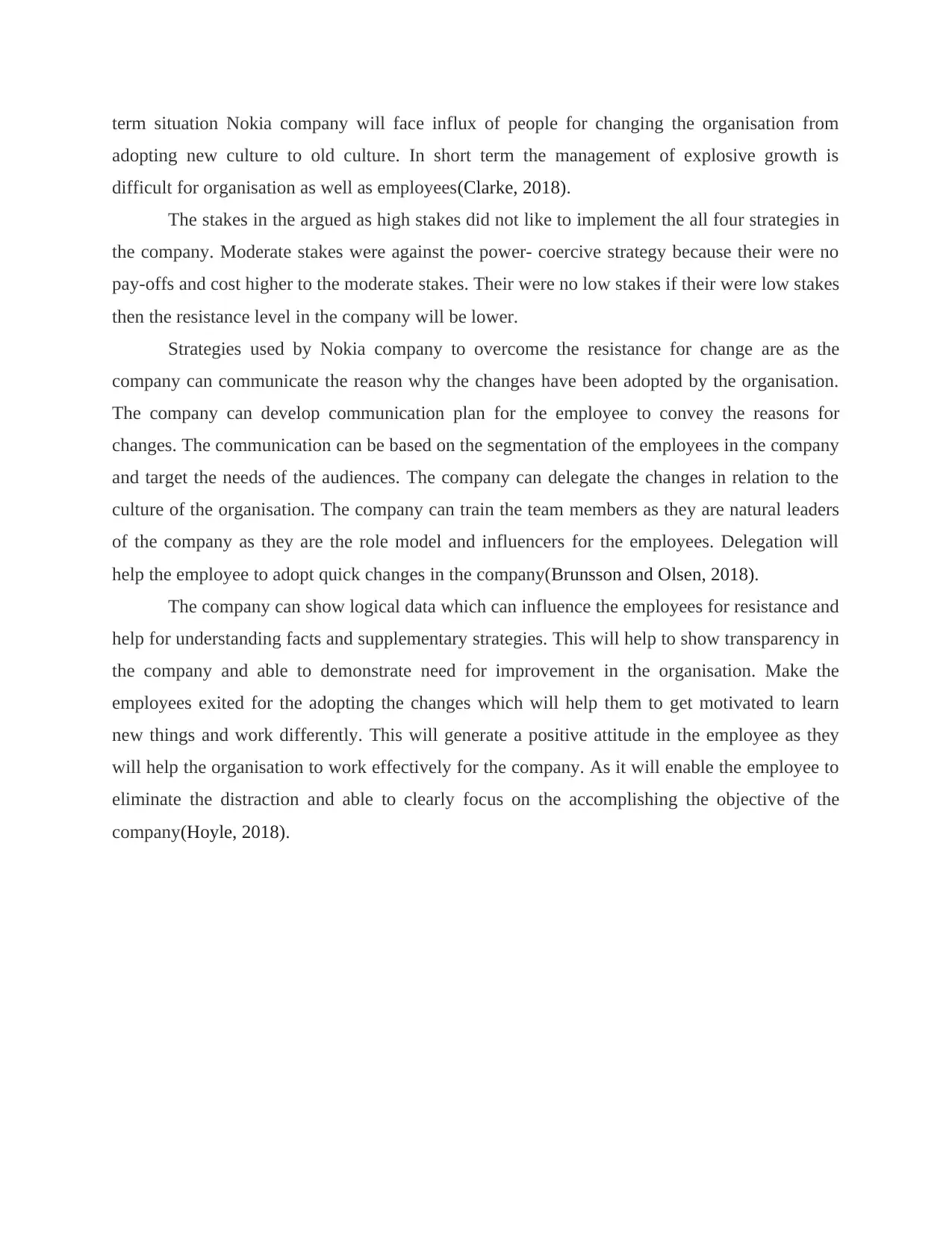
term situation Nokia company will face influx of people for changing the organisation from
adopting new culture to old culture. In short term the management of explosive growth is
difficult for organisation as well as employees(Clarke, 2018).
The stakes in the argued as high stakes did not like to implement the all four strategies in
the company. Moderate stakes were against the power- coercive strategy because their were no
pay-offs and cost higher to the moderate stakes. Their were no low stakes if their were low stakes
then the resistance level in the company will be lower.
Strategies used by Nokia company to overcome the resistance for change are as the
company can communicate the reason why the changes have been adopted by the organisation.
The company can develop communication plan for the employee to convey the reasons for
changes. The communication can be based on the segmentation of the employees in the company
and target the needs of the audiences. The company can delegate the changes in relation to the
culture of the organisation. The company can train the team members as they are natural leaders
of the company as they are the role model and influencers for the employees. Delegation will
help the employee to adopt quick changes in the company(Brunsson and Olsen, 2018).
The company can show logical data which can influence the employees for resistance and
help for understanding facts and supplementary strategies. This will help to show transparency in
the company and able to demonstrate need for improvement in the organisation. Make the
employees exited for the adopting the changes which will help them to get motivated to learn
new things and work differently. This will generate a positive attitude in the employee as they
will help the organisation to work effectively for the company. As it will enable the employee to
eliminate the distraction and able to clearly focus on the accomplishing the objective of the
company(Hoyle, 2018).
adopting new culture to old culture. In short term the management of explosive growth is
difficult for organisation as well as employees(Clarke, 2018).
The stakes in the argued as high stakes did not like to implement the all four strategies in
the company. Moderate stakes were against the power- coercive strategy because their were no
pay-offs and cost higher to the moderate stakes. Their were no low stakes if their were low stakes
then the resistance level in the company will be lower.
Strategies used by Nokia company to overcome the resistance for change are as the
company can communicate the reason why the changes have been adopted by the organisation.
The company can develop communication plan for the employee to convey the reasons for
changes. The communication can be based on the segmentation of the employees in the company
and target the needs of the audiences. The company can delegate the changes in relation to the
culture of the organisation. The company can train the team members as they are natural leaders
of the company as they are the role model and influencers for the employees. Delegation will
help the employee to adopt quick changes in the company(Brunsson and Olsen, 2018).
The company can show logical data which can influence the employees for resistance and
help for understanding facts and supplementary strategies. This will help to show transparency in
the company and able to demonstrate need for improvement in the organisation. Make the
employees exited for the adopting the changes which will help them to get motivated to learn
new things and work differently. This will generate a positive attitude in the employee as they
will help the organisation to work effectively for the company. As it will enable the employee to
eliminate the distraction and able to clearly focus on the accomplishing the objective of the
company(Hoyle, 2018).
⊘ This is a preview!⊘
Do you want full access?
Subscribe today to unlock all pages.

Trusted by 1+ million students worldwide
1 out of 18
Related Documents
Your All-in-One AI-Powered Toolkit for Academic Success.
+13062052269
info@desklib.com
Available 24*7 on WhatsApp / Email
![[object Object]](/_next/static/media/star-bottom.7253800d.svg)
Unlock your academic potential
Copyright © 2020–2025 A2Z Services. All Rights Reserved. Developed and managed by ZUCOL.





